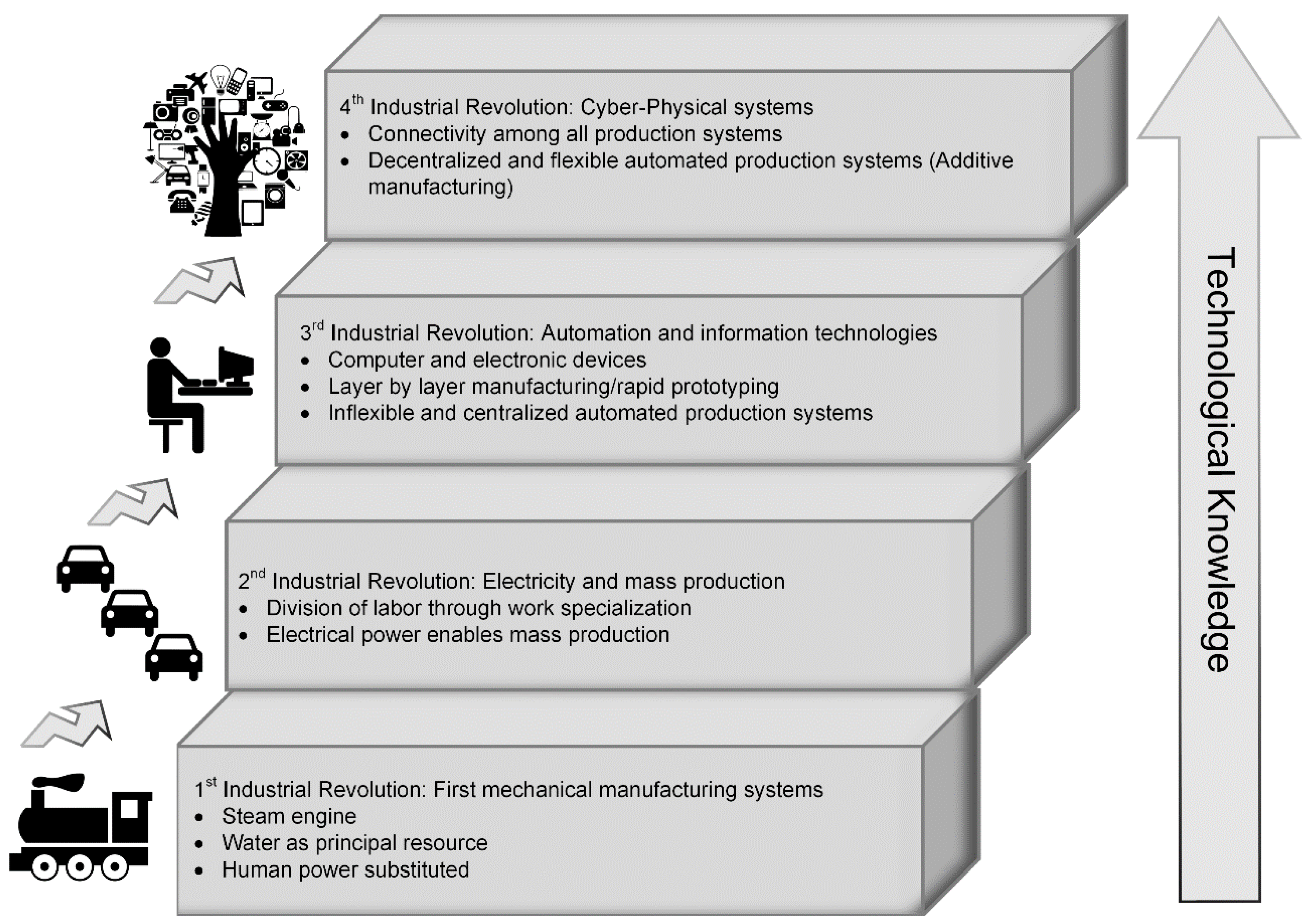Systematic Literature Review: Integration of Additive Manufacturing and Industry 4.0
Abstract
1. Introduction
2. Background
2.1. Additive Manufacturing
2.2. Industry 4.0
3. Materials and Methods
- I 1. Article type must be research paper, proceedings paper, or review
- I 2. Article must be in English
- I 3. Articles must be from 2018 Journal Citation Report
4. Results
4.1. Bibliometric Findings
4.2. Recent Developments in AM
4.2.1. Developments in BI
4.2.2. Developments in Sustainability
5. Discussion
6. Conclusions
Author Contributions
Funding
Acknowledgments
Conflicts of Interest
References
- Attaran, M. The rise of 3-D printing: The advantages of additive manufacturing over traditional manufacturing. Bus. Horiz. 2017, 60, 677–688. [Google Scholar] [CrossRef]
- Wohlers, T. Wohlers Report 2015: Additive Manufacturing and 3D printing State of the Industry Annual Worldwide Progress Report. Wohlers Assoc. 2014, 24, 1–34. [Google Scholar]
- Bogers, M.; Hadar, R.; Bilberg, A. Additive manufacturing for consumer-centric business models: Implications for supply chains in consumer goods manufacturing. Technol. Forecast. Soc. Chang. 2016, 102, 225–239. [Google Scholar] [CrossRef]
- Rayna, T.; Striukova, L. From rapid prototyping to home fabrication: How 3D printing is changing business model innovation. Technol. Forecast. Soc. Chang. 2016, 102, 214–224. [Google Scholar] [CrossRef]
- Thomas, D. Costs, benefits, and adoption of additive manufacturing: A supply chain perspective. Int. J. Adv. Manuf. Technol. 2016, 85, 1857–1876. [Google Scholar] [CrossRef] [PubMed]
- Urbanic, R.J.J.; Saqib, S.M.M. A manufacturing cost analysis framework to evaluate machining and fused filament fabrication additive manufacturing approaches. Int. J. Adv. Manuf. Technol. 2019, 102, 3091–3108. [Google Scholar] [CrossRef]
- Westerweel, B.; Basten, R.J.I.; van Houtum, G.-J. Traditional or Additive Manufacturing? Assessing Component Design Options through Lifecycle Cost Analysis. Eur. J. Oper. Res. 2018, 270, 570–585. [Google Scholar] [CrossRef]
- Thompson, M.K.; Moroni, G.; Vaneker, T.; Fadel, G.; Campbell, R.I.; Gibson, I.; Bernard, A.; Schulz, J.; Graf, P.; Ahuja, B.; et al. Design for Additive Manufacturing: Trends, opportunities, considerations, and constraints. Cirp Ann. Manuf. Technol. 2016, 65, 737–760. [Google Scholar] [CrossRef]
- Chen, D.; Heyer, S.; Ibbotson, S.; Salonitis, K.; Steingrímsson, J.G.; Thiede, S.; Steingrimsson, J.G.; Thiede, S.; Steingrímsson, J.G.; Thiede, S.; et al. Direct digital manufacturing: Definition, evolution, and sustainability implications. J. Clean. Prod. 2015, 107, 615–625. [Google Scholar] [CrossRef]
- Chitrao, P. 21st C New Technologies a Pathway to Inclusive and Sustainable Growth. Inf. Syst. Des. Intell. Appl. 2016, 434, 395–402. [Google Scholar]
- Gwamuri, J.; Franco, D.; Khan, K.Y.; Gauchia, L.; Pearce, J.M. High-Efficiency Solar-Powered 3-D Printers for Sustainable Development. Machines 2016, 4, 3. [Google Scholar] [CrossRef]
- Savastano, M.; Bellini, F.; D’Ascenzo, F.; Scornavacca, E. FabLabs as Platforms for Digital Fabrication Services: A Literature Analysis. In Proceedings of the Exploring Services Science, IESS 2017; Za, S., Dragoicea, M., Cavallari, M., Eds.; Gewerbestrasse 11, CH-6330; Springer International Publishing Ag: Cham, Switzerland, 2017; Volume 279, pp. 24–37. [Google Scholar]
- Costabile, G.; Fera, M.; Fruggiero, F.; Lambiase, A.; Pham, D. Cost models of additive manufacturing: A literature review. Int. J. Ind. Eng. Comput. 2017, 8, 263–282. [Google Scholar] [CrossRef]
- Agrawal, R.; Vinodh, S. State of art review on sustainable additive manufacturing. Rapid Prototyp. J. 2019, 25, 1045–1060. [Google Scholar] [CrossRef]
- Godina, R.; Espadinha-Cruz, P.; Ferreira, I.A.; Brás, I.; Matos, F. Knowledge Management and Additive Manufacturing Technology: A Literature Review. In Proceedings of the ECKM 2019 20th European Conference on Knowledge Management 2 VOLS; Academic Conferences and Publishing Limited: Amsterdam, The Nederlands, 2019; p. 398. [Google Scholar]
- Savolainen, J.; Collan, M. Additive manufacturing technology and business model change – a review of literature. Addit. Manuf. 2020, 101070. [Google Scholar] [CrossRef]
- Lu, Y. Industry 4.0: A Survey on Technologies, Applications and Open Research Issues; Elsevier B.V.: Amsterdam, The Netherlands, 2017; Volume 6, pp. 1–10. [Google Scholar]
- Shrouf, F.; Ordieres, J.; Miragliotta, G. Smart factories in Industry 4.0: A review of the concept and of energy management approached in production based on the Internet of Things paradigm. IEEE Int. Conf. Ind. Eng. Eng. Manag. 2014, 2015, 697–701. [Google Scholar]
- Qin, J.; Liu, Y.; Grosvenor, R.; Lacan, F.; Jiang, Z. Deep learning-driven particle swarm optimisation for additive manufacturing energy optimisation. J. Clean. Prod. 2020, 245, 118702. [Google Scholar] [CrossRef]
- Turner, C.; Moreno, M.; Mondini, L.; Salonitis, K.; Charnley, F.; Tiwari, A.; Hutabarat, W. Sustainable Production in a Circular Economy: A Business Model for Re-Distributed Manufacturing. Sustainability 2019, 11, 4291. [Google Scholar] [CrossRef]
- Asociación Española de Normalización y Certificación. Norma Española Fabricación aditiva Principios generales ISO/ASTM 52900:2015; Asociación Española de Normalización y Certificación: Madrid, Spain, 2017. [Google Scholar]
- Blaya, F.; San Pedro, P.; Lopez Silva, J.; D’Amato, R.; Soriano Heras, E.; Antonio Juanes, J.; Pedro, P.S.; Silva, J.L.; D’Amato, R.; Heras, E.S.; et al. Design of an Orthopedic Product by Using Additive Manufacturing Technology: The Arm Splint. J. Med. Syst. 2018, 42, 54. [Google Scholar] [CrossRef]
- Dias, M.R.; Guedes, J.M.; Flanagan, C.L.; Hollister, S.J.; Fernandes, P.R. Optimization of scaffold design for bone tissue engineering: A computational and experimental study. Med. Eng. Phys. 2014, 36, 448–457. [Google Scholar] [CrossRef]
- Santolaria, J.; Monge, R.; Tobajas, Á.; Jimenez, R.; Cabrera, M.A.; Fernandez, L.J. Design, manufacture and geometric verification of rapid prototyped microfluidic encapsulations by computed tomography. Comput. Ind. 2013. [Google Scholar] [CrossRef]
- Sutradhar, A.; Park, J.; Carrau, D.; Nguyen, T.H.; Miller, M.J.; Paulino, G.H.; Nguyen, T.H.; Miller, M.J.; Paulino, G.H. Designing patient-specific 3D printed craniofacial implants using a novel topology optimization method. Med. Biol. Eng. Comput. 2016, 54, 1123–1135. [Google Scholar] [CrossRef] [PubMed]
- Zadpoor, A.A. Design for Additive Bio-Manufacturing: From Patient-Specific Medical Devices to Rationally Designed Meta-Biomaterials. Int. J. Mol. Sci. 2017, 18, 1607. [Google Scholar] [CrossRef] [PubMed]
- Holzmann, P.; Breitenecker, R.J.R.J.R.J.; Soomro, A.A.A.A.; Schwarz, E.J.E.J. User entrepreneur business models in 3D printing. J. Manuf. Technol. Manag. 2017, 28, 75–94. [Google Scholar] [CrossRef]
- Laplume, A.; Anzalone, G.C.G.C.; Pearce, J.M.J.M. Open-source, self-replicating 3-D printer factory for small-business manufacturing. Int. J. Adv. Manuf. Technol. 2016, 85, 633–642. [Google Scholar] [CrossRef]
- Rong, K.; Patton, D.; Chen, W. Business models dynamics and business ecosystems in the emerging 3D printing industry. Technol. Forecast. Soc. Chang. 2018, 134, 234–245. [Google Scholar] [CrossRef]
- Chen, C.; Shen, Y.; Tsai, H.-L. A Foil-Based Additive Manufacturing Technology for Metal Parts. J. Manuf. Sci. Eng. 2016, 139, 024501. [Google Scholar] [CrossRef]
- Murmura, F.; Bravi, L. Additive manufacturing in the wood-furniture sector: Sustainability of the technology, benefits and limitations of adoption. J. Manuf. Technol. Manag. 2018, 29, 350–371. [Google Scholar] [CrossRef]
- Zhong, S.; Pearce, J.M. Tightening the loop on the circular economy: Coupled distributed recycling and manufacturing with recyclebot and RepRap 3-D printing. Resour. Conserv. Recycl. 2018, 128, 48–58. [Google Scholar] [CrossRef]
- Miao, X.; Zhang, Q.; Atkin, C.; Sun, Z.; Li, Y. Improving Purge Air Cooling Effectiveness by Engineered End-Wall SurfaceStructures-Part I: Duct Flow. J. Turbomach. Trans. Asme 2018, 140. [Google Scholar]
- Pelanconi, M.; Barbato, M.; Zavattoni, S.; Vignoles, G.L.; Ortona, A. Thermal design, optimization and additive manufacturing of ceramic regular structures to maximize the radiative heat transfer. Mater. Des. 2019, 163. [Google Scholar] [CrossRef]
- Wu, J.; Clausen, A.; Sigmund, O. Minimum compliance topology optimization of shell-infill composites foradditive manufacturing. Comput. Methods Appl. Mech. Eng. 2017, 326, 358–375. [Google Scholar] [CrossRef]
- Mattos Nascimento, D.L.; Alencastro, V.; Goncalves Quelhas, O.L.; Gusmao Caiado, R.G.; Garza-Reyes, J.A.J.A.J.A.; Lona, L.R.L.R.L.R.; Tortorella, G.; Nascimento, D.L.M.D.L.M.; Alencastro, V.; Quelhas, O.L.G.O.L.G.; et al. Exploring Industry 4.0 technologies to enable circular economy practices in a manufacturing context A business model proposal. J. Manuf. Technol. Manag. 2019, 30, 607–627. [Google Scholar] [CrossRef]
- Ghobakhloo, M. The future of manufacturing industry: A strategic roadmap toward Industry 4.0. J. Manuf. Technol. Manag. 2018, 29, 910–936. [Google Scholar] [CrossRef]
- Atzeni, E.; Iuliano, L.; Minetola, P.; Salmi, A. Redesign and cost estimation of rapid manufactured plastic parts. Rapid Prototyp. J. 2010, 16, 308–317. [Google Scholar] [CrossRef]
- Telenko, C.; Seepersad, C.C. A comparison of the energy efficiency of selective laser sintering and injection molding of nylon parts. Rapid Prototyp. J. 2012, 18, 472–481. [Google Scholar] [CrossRef]
- Hopkinson, N.; Dickens, P. Analysis of rapid manufacturing—using layer manufacturing processes for production. Mech. Eng. Sci. 2003, 217, 31–39. [Google Scholar] [CrossRef]
- Amir Sasson, J.C.J. The 3D printing order: Variability, supercenters and supply chain reconfigurations. Int. J. Phys. Distrib. Logist. Manag. 2016, 46, 88–94. [Google Scholar]
- Santander, P.; Cruz, F.; Boudaoud, H.; Camargo, M. 3D-Printing based distributed plastic recycling: A conceptual model for closed-loop supply chain design. In Proceedings of the 2018 IEEE International Conference on Engineering, Technology and Innovation (ICE/ITMC), Stuttgart, Germany, 17–20 June 2018. [Google Scholar]
- Santos, G.; Murmura, F.; Bravi, L. Fabrication laboratories: The development of new business models with new digital technologies. J. Manuf. Technol. Manag. 2018, 29, 1332–1357. [Google Scholar] [CrossRef]
- Mosconi, F. The New European Industrial Policy: Global Competitiveness and the Manufacturing Renaissance; Routledge—Taylor and Francis Group: Oxfordshire, UK, 2015; ISBN 9781317646129. [Google Scholar]
- Roblek, V.; Meško, M.; Krapež, A. A Complex View of Industry 4.0. Sage Open 2016, 6, 215824401665398. [Google Scholar] [CrossRef]
- Egger, J.; Masood, T. Augmented reality in support of intelligent manufacturing—A systematic literature review. Comput. Ind. Eng. 2020, 140. [Google Scholar] [CrossRef]
- Xu, L.D.; Xu, E.L.; Li, L. Industry 4.0: State of the art and future trends. Int. J. Prod. Res. 2018, 56, 2941–2962. [Google Scholar] [CrossRef]
- Baheti, R.; Gill, H. Cyber-physical Systems. Impact Control Technol. 2011, 12, 161–166. [Google Scholar]
- Manyika, J.; Chui, M.; Bughin, J.; Dobbs, R.; Bisson, P.; Marrs, A. Disruptive Technologies: Advances that Will Transform Life, Business, and the Global Economy; McKinsey Global Institute: New York, NY, USA, 2013. [Google Scholar]
- Lasi, H.; Fettke, P.; Kemper, H.G.; Feld, T.; Hoffmann, M. Industry 4.0. Bus. Inf. Syst. Eng. 2014, 6, 239–242. [Google Scholar] [CrossRef]
- Kamble, S.S.; Gunasekaran, A.; Gawankar, S.A. Sustainable Industry 4.0 framework: A systematic literature review identifying the current trends and future perspectives. Process Saf. Environ. Prot. 2018, 117, 408–425. [Google Scholar] [CrossRef]
- Beatriz, A.; De Sousa, L.; Charbel, J.; Chiappetta, J.; Godinho, M.; David, F. Industry 4.0 and the circular economy: A proposed research agenda and original roadmap for sustainable operations. Ann. Oper. Res. 2018, 270, 273–286. [Google Scholar]
- Dev, N.K.; Shankar, R.; Hasan, F. Resources, Conservation & Recycling Industry 4.0 and circular economy: Operational excellence for sustainable reverse supply chain performance. Resour. Conserv. Recycl. 2020, 153, 104583. [Google Scholar]
- Bienhaus, F.; Haddud, A. Procurement 4.0: Factors influencing the digitisation of procurement and supply chains. Bus. Process Manag. J. 2018, 24, 965–984. [Google Scholar] [CrossRef]
- Ibarra, D.; Ganzarain, J.; Igartua, J.I. Business model innovation through Industry 4.0: A review. In Proceedings of the Procedia Manufacturing; Elsevier B.V.: Amsterdam, The Netherlands, 2018; Volume 22, pp. 4–10. [Google Scholar]
- Ren, L.; Wang, S.; Shen, Y.; Hong, S.; Chen, Y.; Zhang, L. 3D Printing in Cloud Manufacturing: Model and Platform Design. In Proceedings of the Proceedings of the ASME 11th International Manufacturing Science and Engineering Conference, Blacksburg, VA, USA, 27 June–1 July 2016. [Google Scholar]
- Ivanov, D.; Dolgui, A.; Sokolov, B. The impact of digital technology and Industry 4.0 on the ripple effect and supply chain risk analytics. Int. J. Prod. Res. 2019, 57, 829–846. [Google Scholar] [CrossRef]
- Heck, S.; Rogers, M.; Carroll, P. Resource revolution: How to Capture the Biggest Business Opportunity in a Century; Houghton Mifflin Harcourt: Boston, MA, USA, 2014. [Google Scholar]
- Moher, D.; Liberati, A.; Tetzlaff, J.; Altman, D.G.; Altman, D.; Antes, G.; Atkins, D.; Barbour, V.; Barrowman, N.; Berlin, J.A.; et al. Preferred reporting items for systematic reviews and meta-analyses: The PRISMA statement. PLoS Med. 2009, 6, e1000097. [Google Scholar] [CrossRef]
- Aghaei Chadegani, A.; Salehi, H.; Md Yunus, M.M.; Farhadi, H.; Fooladi, M.; Farhadi, M.; Ale Ebrahim, N. A comparison between two main academic literature collections: Web of science and scopus databases. Asian Soc. Sci. 2013, 9, 18–26. [Google Scholar] [CrossRef]
- Persson, O.; Danell, R.; Schneider, J.W. How to use Bibexcel for various types of bibliometric analysis. In Celebrating Scholarly Communication Studies: A Festschrift for Olle Persson at His 60th Birthday; Åström, F., Danell, R., Larsen, B., Schneider, J., Eds.; International Society for Scientometrics and Informetrics: Leuven, Belgium, 2009; pp. 9–24. [Google Scholar]
- Aria, M.; Cuccurullo, C. Bibliometrix: An R-tool for comprehensive science mapping analysis. J. Informetr. 2017, 11, 959–975. [Google Scholar] [CrossRef]
- Wittbrodt, B.T.T.; Glover, A.G.G.; Laureto, J.; Anzalone, G.C.C.; Oppliger, D.; Irwin, J.L.L.; Pearce, J.M.M. Life-cycle economic analysis of distributed manufacturing with open-source 3-D printers. Mechatronics 2013, 23, 713–726. [Google Scholar] [CrossRef]
- ASTM International. ASTM F2792-09 Standard Terminology for Additive Manufacturing Technologies; ASTM International: West Conshohocken, PA, USA, 2012. [Google Scholar]
- Atzeni, E.; Salmi, A. Economics of additive manufacturing for end-usable metal parts. Int. J. Adv. Manuf. Technol. 2012, 62, 1147–1155. [Google Scholar] [CrossRef]
- Ruffo, M.; Tuck, C.; Hague, R. Cost estimation for rapid manufacturing - laser sintering production for low to medium volumes. Proc. Inst. Mech. Eng. Part B-J. Eng. Manuf. 2006, 220, 1417–1427. [Google Scholar] [CrossRef]
- Rickenbacher, L.; Spierings, A.; Wegener, K. An integrated cost-model for selective laser melting (SLM). Rapid Prototyp. J. 2013, 19, 208–214. [Google Scholar] [CrossRef]
- Ruffo, M.; Hague, R. Cost estimation for rapid manufacturing - Simultaneous production of mixed components using laser sintering. Proc. Inst. Mech. Eng. Part B J. Eng. Manuf. 2007, 221, 1585–1591. [Google Scholar] [CrossRef]
- Subburaj, K.; Ravi, B. Computer aided rapid tooling process selection and manufacturability evaluation for injection mold development. Comput. Ind. 2008, 59, 262–276. [Google Scholar] [CrossRef]
- Jia, F.; Wang, X.; Mustafee, N.; Hao, L. Investigating the feasibility of supply chain-centric business models in 3D chocolate printing: A simulation study. Technol. Forecast. Soc. Chang. 2016, 102, 202–213. [Google Scholar] [CrossRef]
- Folgado, R.; Peças, P.; Henriques, E. Life cycle cost for technology selection: A Case study in the manufacturing of injection moulds. Int. J. Prod. Econ. 2010, 128, 368–378. [Google Scholar] [CrossRef]
- Gebler, M.; Uiterkamp, A.J.M.S.; Visser, C. A global sustainability perspective on 3D printing technologies. Energy Policy 2014, 74, 158–167. [Google Scholar] [CrossRef]
- Despeisse, M.; Baumers, M.; Brown, P.; Charnley, F.; Ford, S.J.; Garmulewicz, A.; Knowles, S.; Minshall, T.H.W.; Mortara, L.; Reed-Tsochas, F.P.; et al. Unlocking value for a circular economy through 3D printing: A research agenda. Technol. Forecast. Soc. Chang. 2017, 115, 75–84. [Google Scholar] [CrossRef]
- Bordin, A.; Sartori, S.; Bruschi, S.; Ghiotti, A. Experimental investigation on the feasibility of dry and cryogenic machining as sustainable strategies when turning Ti6Al4V produced by Additive Manufacturing. J. Clean. Prod. 2017, 142, 4142–4151. [Google Scholar] [CrossRef]
- Tang, Y.; Mak, K.; Zhao, Y.F. A framework to reduce product environmental impact through design optimization for additive manufacturing. J. Clean. Prod. 2016, 137, 1560–1572. [Google Scholar] [CrossRef]
- Kucherov, F.A.; Gordeev, E.G.; Kashin, A.S.; Ananikov, V.P. Three-Dimensional Printing with Biomass-Derived PEF for Carbon-Neutral Manufacturing. Angew. Chem. Int. Ed. 2017, 56, 15931–15935. [Google Scholar] [CrossRef] [PubMed]
- Priarone, P.C.; Ingarao, G. Towards criteria for sustainable process selection: On the modelling of pure subtractive versus additive/subtractive integrated manufacturing approaches. J. Clean. Prod. 2017, 144, 57–68. [Google Scholar] [CrossRef]
- Voet, V.S.D.; Strating, T.; Schnelting, G.H.M.; Dijkstra, P.; Tietema, M.; Xu, J.; Woortman, A.J.J.; Loos, K.; Jager, J.; Folkersma, R. Biobased Acrylate Photocurable Resin Formulation for Stereolithography 3D Printing. Acs Omega 2018, 3, 1403–1408. [Google Scholar] [CrossRef]
- Ruffo, M.; Tuck, C.; Hague, R. Empirical laser sintering time estimator for Duraform PA. Int. J. Prod. Res. 2006, 44, 5131–5146. [Google Scholar] [CrossRef]
- Baumers, M.; Dickens, P.; Tuck, C.; Hague, R. The cost of additive manufacturing: Machine productivity, economies of scale and technology-push. Technol. Forecast. Soc. Chang. 2016, 102, 193–201. [Google Scholar] [CrossRef]
- Fera, M.; Fruggiero, F.; Costabile, G.; Lambiase, A.; Pham, D.T.T. A new mixed production cost allocation model for additive manufacturing (MiProCAMAM). Int. J. Adv. Manuf. Technol. 2017, 92, 4275–4291. [Google Scholar] [CrossRef]
- Yang, Y.; Li, L. Cost modeling and analysis for Mask Image Projection Stereolithography additive manufacturing: Simultaneous production with mixed geometries. Int. J. Prod. Econ. 2018, 206, 146–158. [Google Scholar] [CrossRef]
- Campbell, I. Stereolithography build time estimation based on volumetric calculations. Rapid Prototyp. J. 2008, 14, 271–279. [Google Scholar] [CrossRef]
- Ingole, D.S.; Deshmukh, T.R.; Kuthe, A.M.; Ashtankar, K.M. Build orientation analysis for minimum cost determination in FDM. Proc. Inst. Mech. Eng. Part B-J. Eng. Manuf. 2011, 225, 1925–1938. [Google Scholar] [CrossRef]
- Alexander, P.; Allen, S.; Dutta, D. Part orientation and build cost determination in layered manufacturing. Comput. Des. 1998, 30, 343–356. [Google Scholar] [CrossRef]
- Flammini, S.; Arcese, G.; Lucchetti, M.C.M.C.; Mortara, L. Business model configuration and dynamics for technology commercialization in mature markets. Br. Food J. 2017, 119, 2340–2358. [Google Scholar] [CrossRef]
- The Ellen MacArthur Foundation What is a Circular Economy? Ellen MacArthur Foundation. Available online: https://www.ellenmacarthurfoundation.org/circular-economy/concept (accessed on 5 October 2019).
- Sauerwein, M.; Doubrovski, E.; Balkenende, R.; Bakker, C. Exploring the potential of additive manufacturing for product design in a circular economy. J. Clean. Prod. 2019, 226, 1138–1149. [Google Scholar] [CrossRef]
- Byard, D.J.; Woern, A.L.; Oakley, R.B.; Fiedler, M.J.; Snabes, S.L.; Pearce, J.M. Green fab lab applications of large-area waste polymer-based additive manufacturing. Addit. Manuf. 2019, 27, 515–525. [Google Scholar] [CrossRef]
- Leino, M.; Pekkarinen, J.; Soukka, R. The role of laser additive manufacturing methods of metals in repair, refurbishment and remanufacturing—Enabling circular economy. Phys. Procedia 2016, 83, 752–760. [Google Scholar] [CrossRef]
- Woern, A.L.; Byard, D.J.; Oakley, R.B.; Fiedler, M.J.; Snabes, S.L.; Pearce, J.M. Fused Particle Fabrication 3-D Printing: Recycled Materials’ Optimization and Mechanical Properties. Materials 2018, 11, 1413. [Google Scholar] [CrossRef]
- Paciorek-Sadowska, J.; Borowicz, M.; Isbrandt, M. New Poly(lactide-urethane-isocyanurate) Foams Based on Bio-Polylactide Waste. Polymers 2019, 11, 481. [Google Scholar] [CrossRef]
- Reich, M.J.; Woern, A.L.; Tanikella, N.G.; Pearce, J.M. Mechanical Properties and Applications of Recycled Polycarbonate Particle Material Extrusion-Based Additive Manufacturing. Materials 2019, 12, 1642. [Google Scholar] [CrossRef] [PubMed]
- Yang, Y.; Li, L.; Pan, Y.; Sun, Z. Energy Consumption Modeling of Stereolithography-Based Additive Manufacturing Toward Environmental Sustainability. J. Ind. Ecol. 2017, 21, S168–S178. [Google Scholar] [CrossRef]
- Kamps, T.; Lutter-Guenther, M.; Seidel, C.; Gutowski, T.; Reinhart, G. Cost- and energy-efficient manufacture of gears by laser beam melting. Cirp J. Manuf. Sci. Technol. 2018, 21, 47–60. [Google Scholar] [CrossRef]
- Yang, S.; Min, W.; Ghibaudo, J.; Zhao, Y.F. Understanding the sustainability potential of part consolidation design supported by additive manufacturing. J. Clean. Prod. 2019, 232, 722–738. [Google Scholar] [CrossRef]
- Xu, J.; Wang, K.; Sheng, H.; Gao, M.; Zhang, S.; Tan, J. Energy efficiency optimization for ecological 3D printing based on adaptive multi-layer customization. J. Clean. Prod. 2020, 245. [Google Scholar] [CrossRef]
- Bours, J.; Adzima, B.; Gladwin, S.; Cabral, J.; Mau, S. Addressing Hazardous Implications of Additive Manufacturing: Complementing Life Cycle Assessment with a Framework for Evaluating Direct Human Health and Environmental Impacts. J. Ind. Ecol. 2017, 21, S25–S36. [Google Scholar] [CrossRef]
- Priarone, P.C.; Campatelli, G.; Montevecchi, F.; Venturini, G.; Settineri, L. A modelling framework for comparing the environmental and economic performance of WAAM-based integrated manufacturing and machining. Cirp Ann. Technol. 2019, 68, 37–40. [Google Scholar] [CrossRef]
- Wahab, D.A.; Azman, A.H. Additive Manufacturing for Repair and Restoration in Remanufacturing: An Overview from Object Design and Systems Perspectives. Processes 2019, 7, 802. [Google Scholar]
- Saboori, A.; Aversa, A.; Marchese, G.; Biamino, S.; Lombardi, M.; Fino, P. Application of Directed Energy Deposition-Based Additive Manufacturing in Repair. Appl. Sci. 2019, 9, 3316. [Google Scholar] [CrossRef]
- Yang, S.; Zhao, Y.F. Additive Manufacturing-Enabled Part Count Reduction: A Lifecycle Perspective. J. Mech. Des. 2018, 140. [Google Scholar] [CrossRef]
- Verma, A.; Rai, R. Sustainability-induced dual-level optimization of additive manufacturing process. Int. J. Adv. Manuf. Technol. 2017, 88, 1945–1959. [Google Scholar] [CrossRef]
- Canciglieri, O.J.; Sant’Anna, Â.M.O.; Machado, L.C. Multi-attribute method for prioritization of sustainable prototyping technologies. Clean Technol. Environ. Policy 2015, 17, 1355–1363. [Google Scholar] [CrossRef]
- Lazarov, B.S.; Sigmund, O.; Meyer, K.E.; Alexandersen, J. Experimental validation of additively manufactured optimized shapes for passive cooling. Appl. Energy 2018, 226, 330–339. [Google Scholar] [CrossRef]
- Al-Ghamdi, K.A. Sustainable FDM additive manufacturing of ABS components with emphasis on energy minimized and time efficient lightweight construction. Int. J. Light. Mater. Manuf. 2019, 2, 338–345. [Google Scholar] [CrossRef]
- Bonnín Roca, J.; Vaishnav, P.; Laureijs, R.E.E.; Mendonça, J.; Fuchs, E.R.H.R.H. Technology cost drivers for a potential transition to decentralized manufacturing. Addit. Manuf. 2019, 28, 136–151. [Google Scholar] [CrossRef]
- Faludi, J.; Van Sice, C.M.; Shi, Y.; Bower, J.; Brooks, O.M.K. Novel materials can radically improve whole-system environmental impacts of additive manufacturing. J. Clean. Prod. 2019, 212, 1580–1590. [Google Scholar] [CrossRef]
- Stephens, B.; Azimi, P.; El Orch, Z.; Ramos, T. Ultrafine particle emissions from desktop 3D printers. Atmos. Environ. 2013, 79, 334–339. [Google Scholar] [CrossRef]
- Yi, L.; Glaessner, C.; Aurich, J.C.J.C.; Gläßner, C.; Aurich, J.C.J.C.; Glaessner, C.; Aurich, J.C.J.C. How to integrate additive manufacturing technologies into manufacturing systems successfully: A perspective from the commercial vehicle industry. J. Manuf. Syst. 2019, 53, 195–211. [Google Scholar] [CrossRef]
- Knofius, N.; van der Heijden, M.C.; Zijm, W.H.M. Consolidating spare parts for asset maintenance with additive manufacturing. Int. J. Prod. Econ. 2019, 208, 269–280. [Google Scholar] [CrossRef]
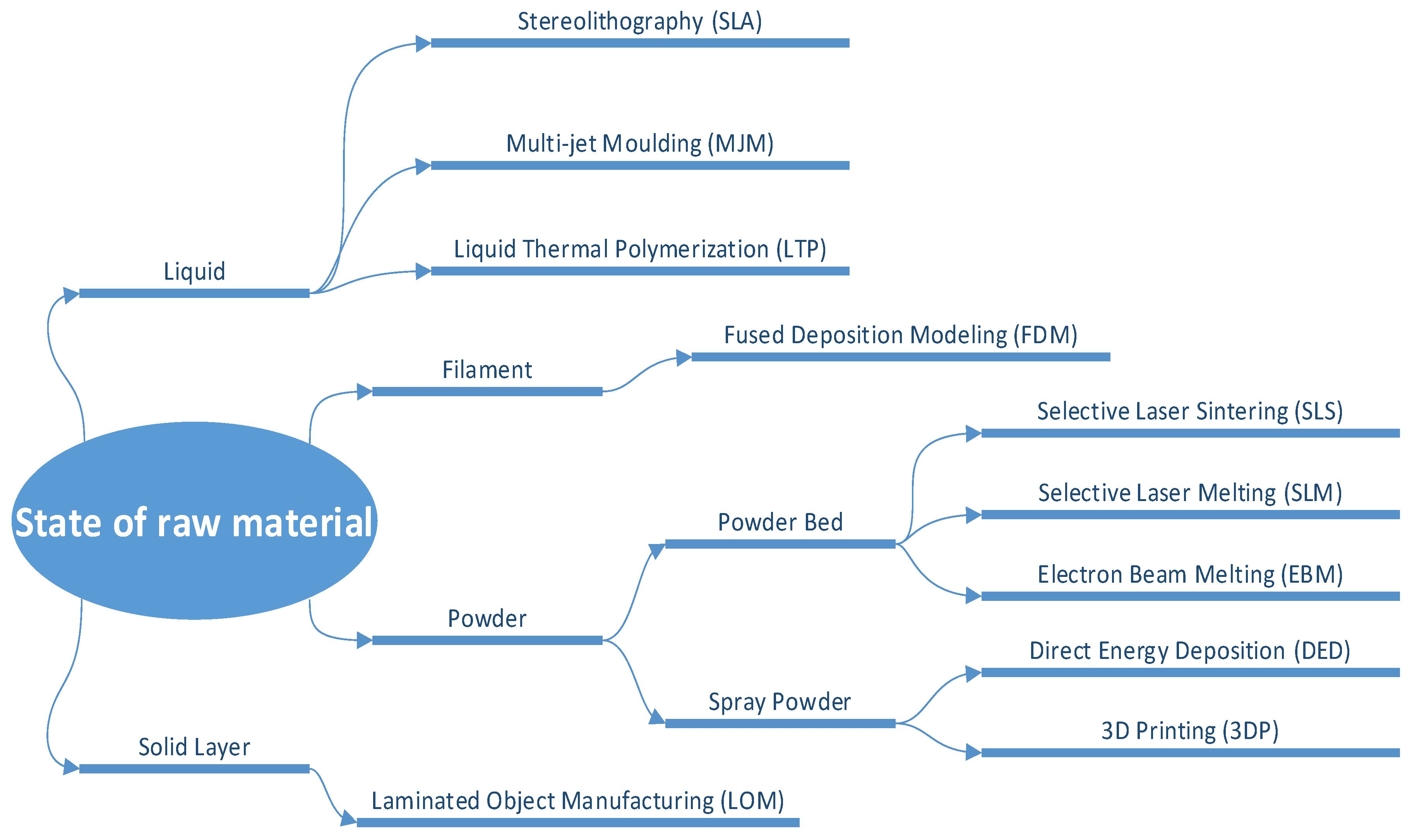
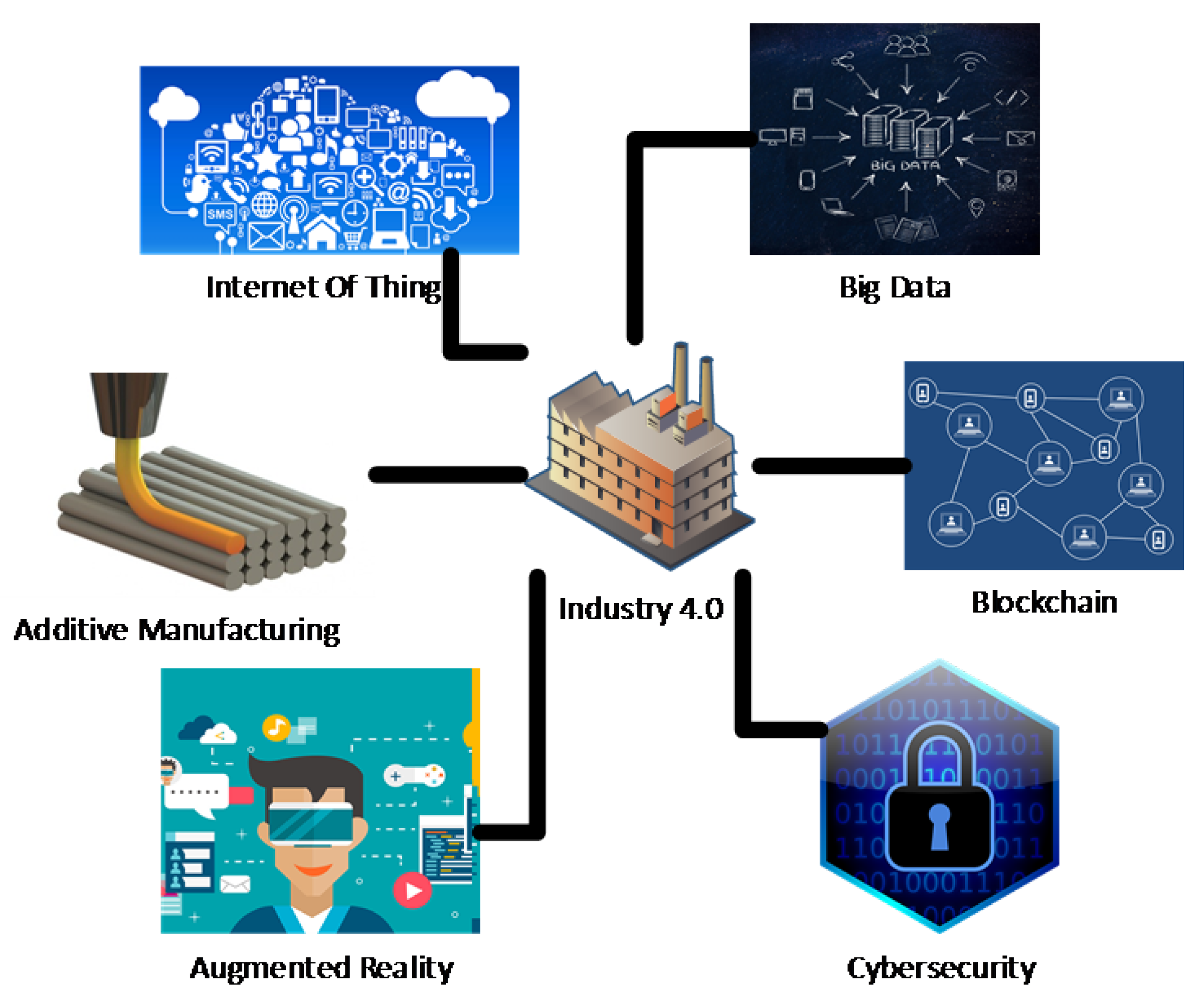
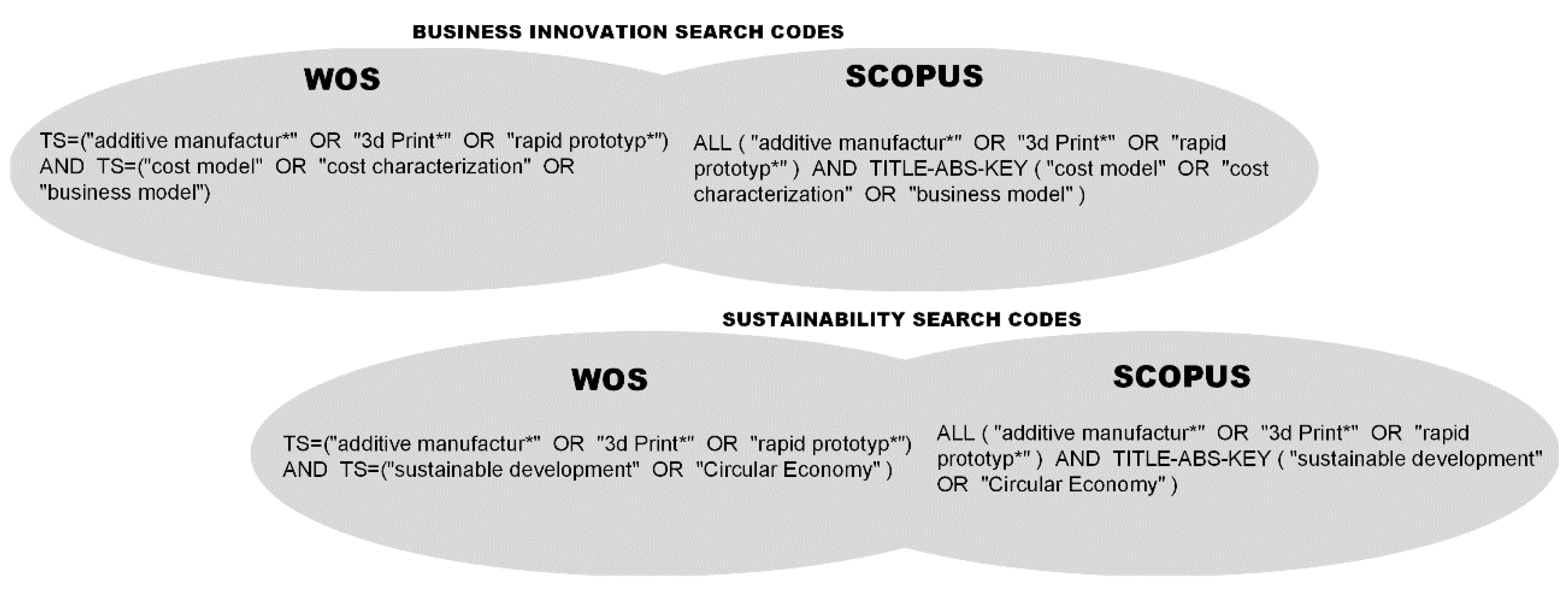
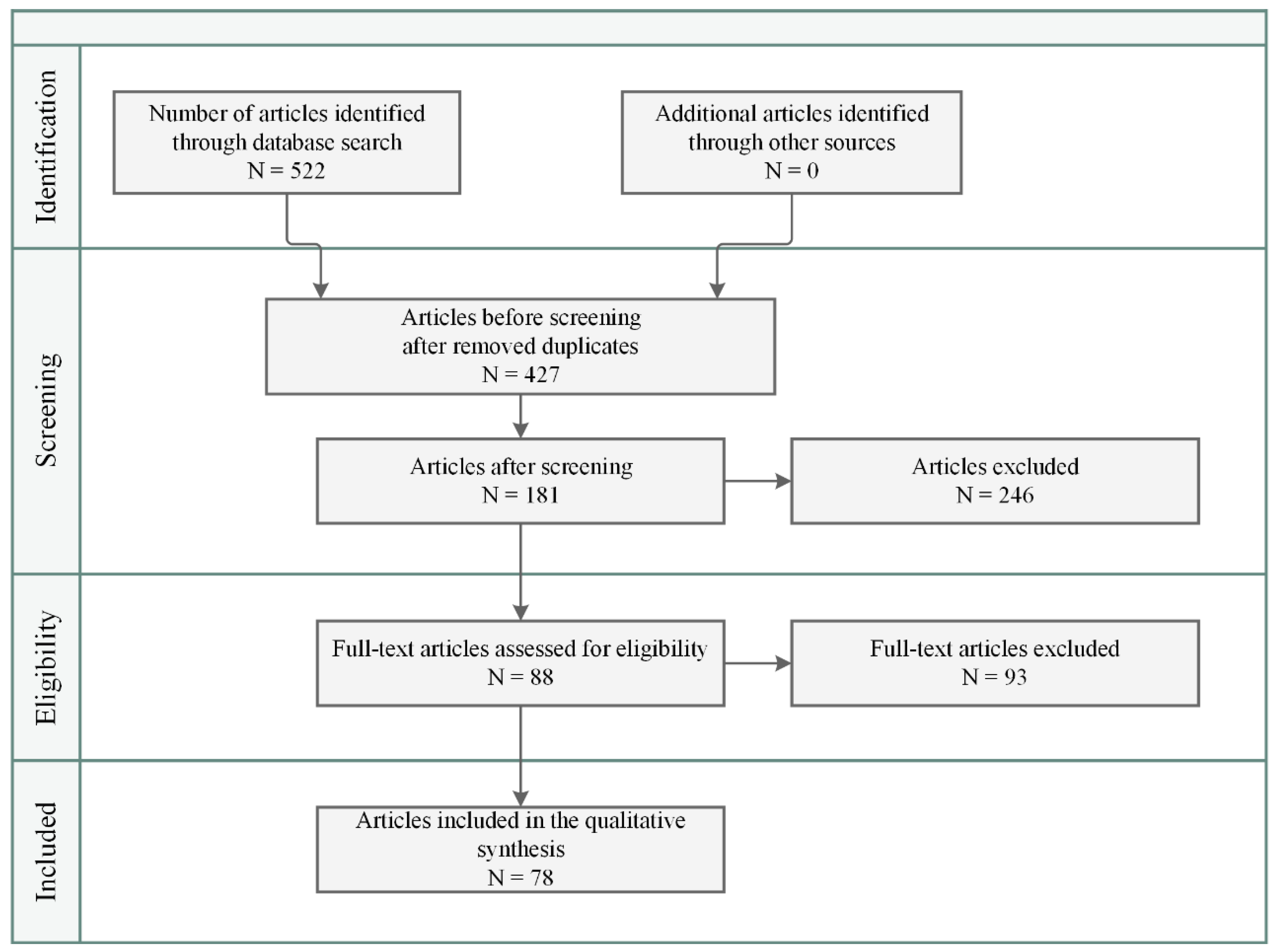
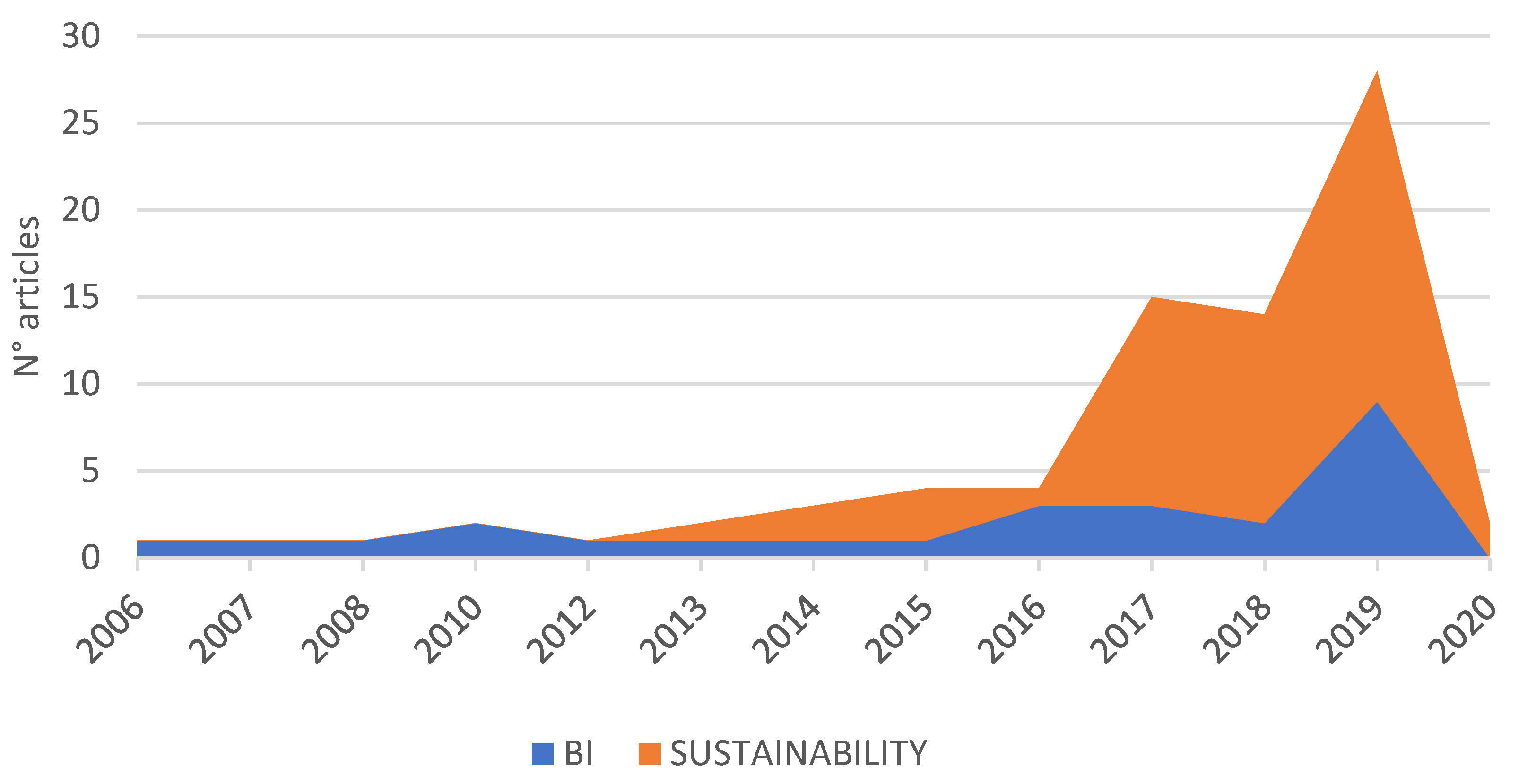
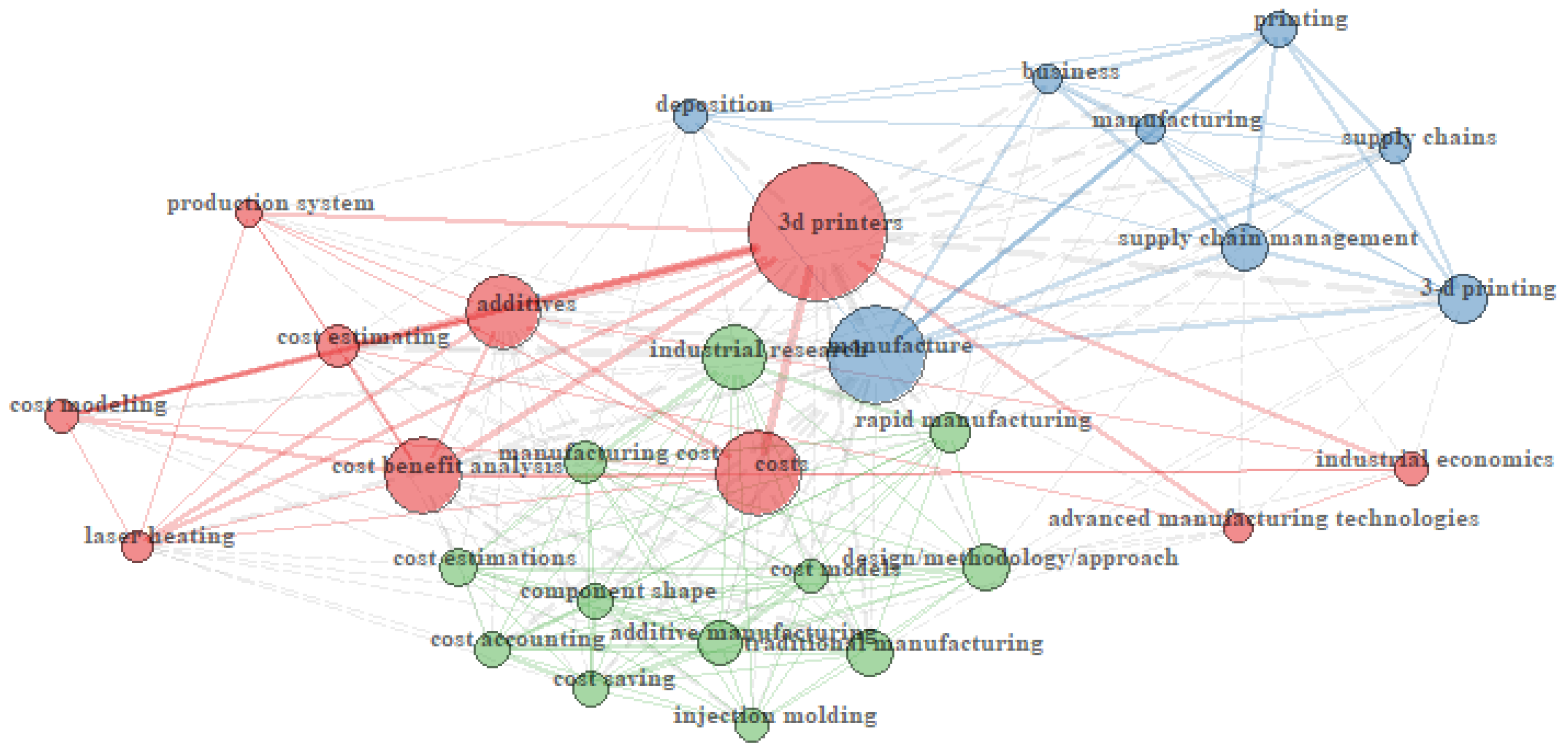

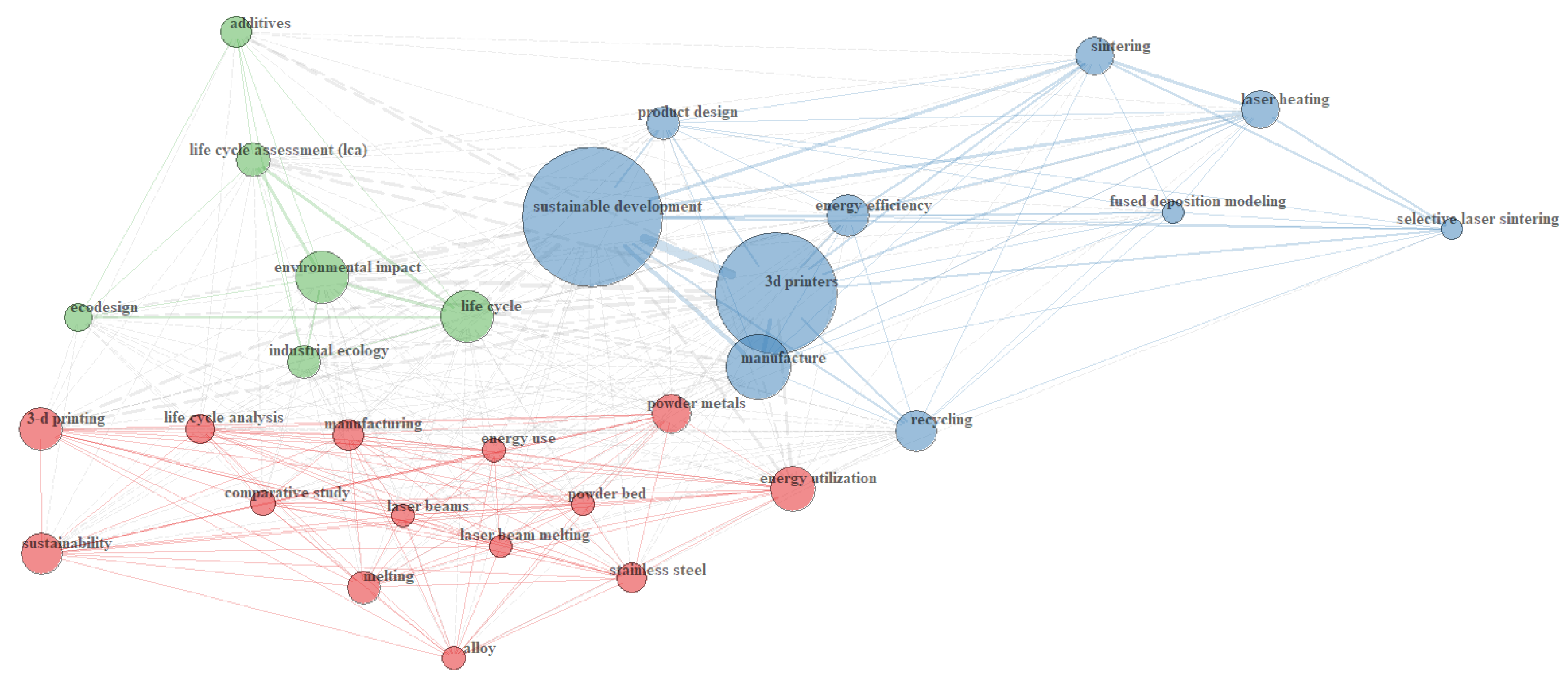
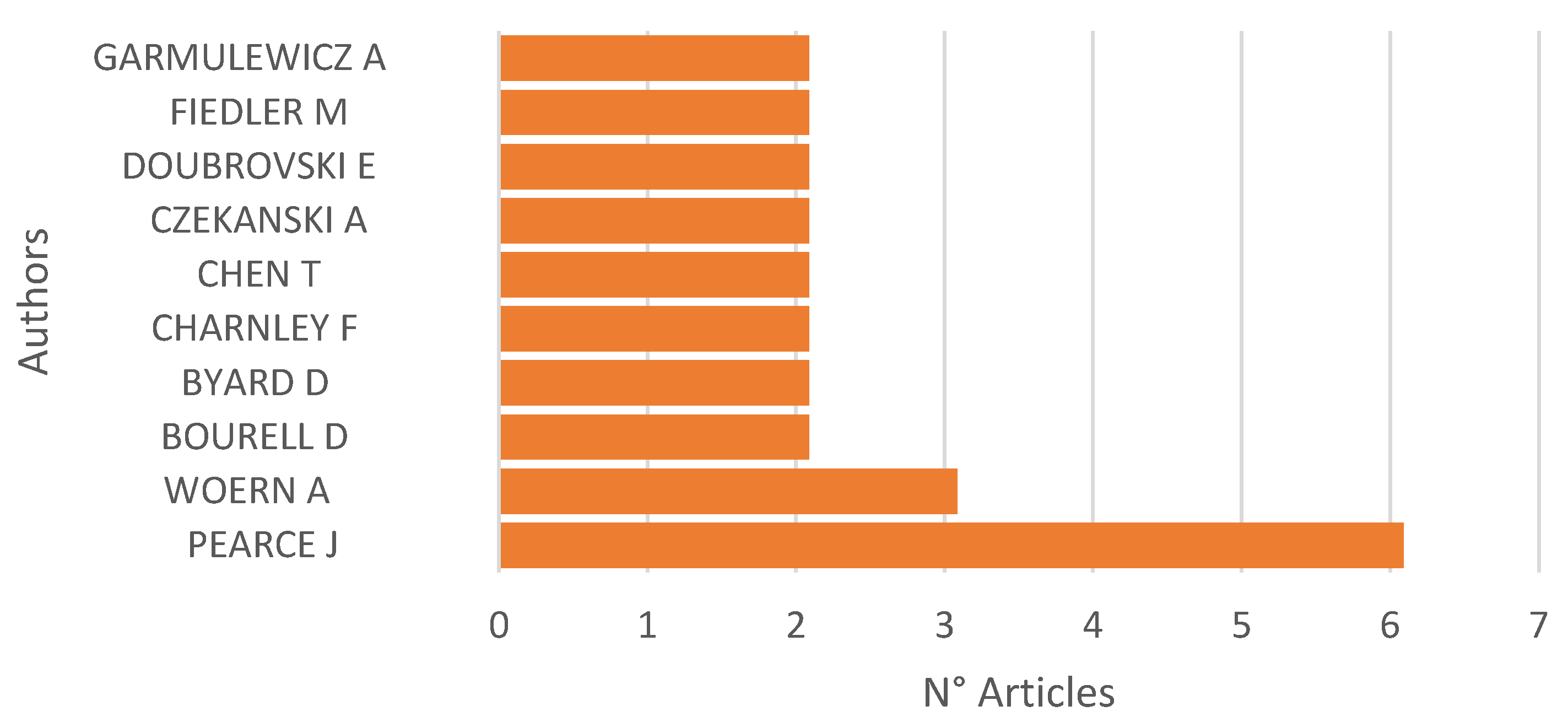
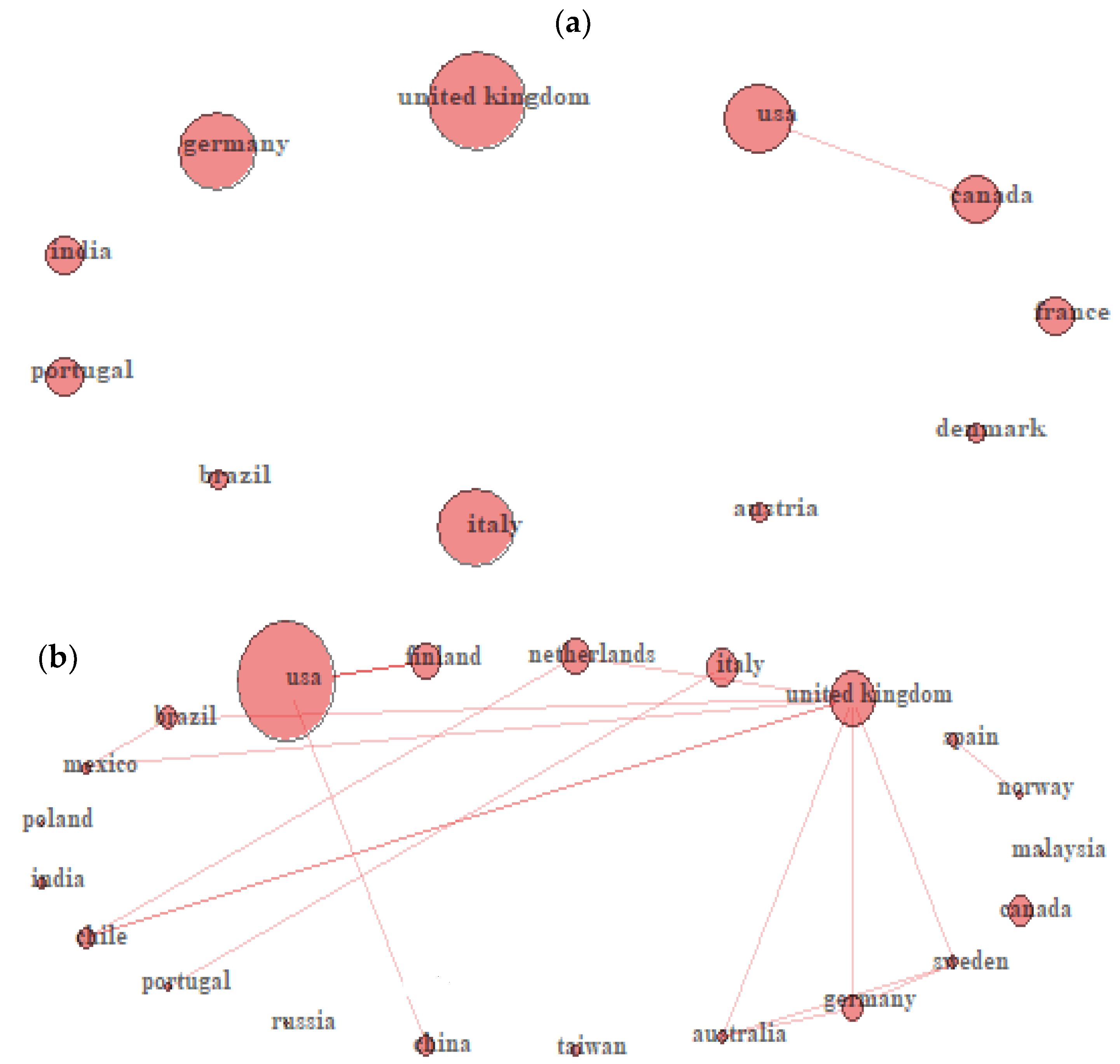

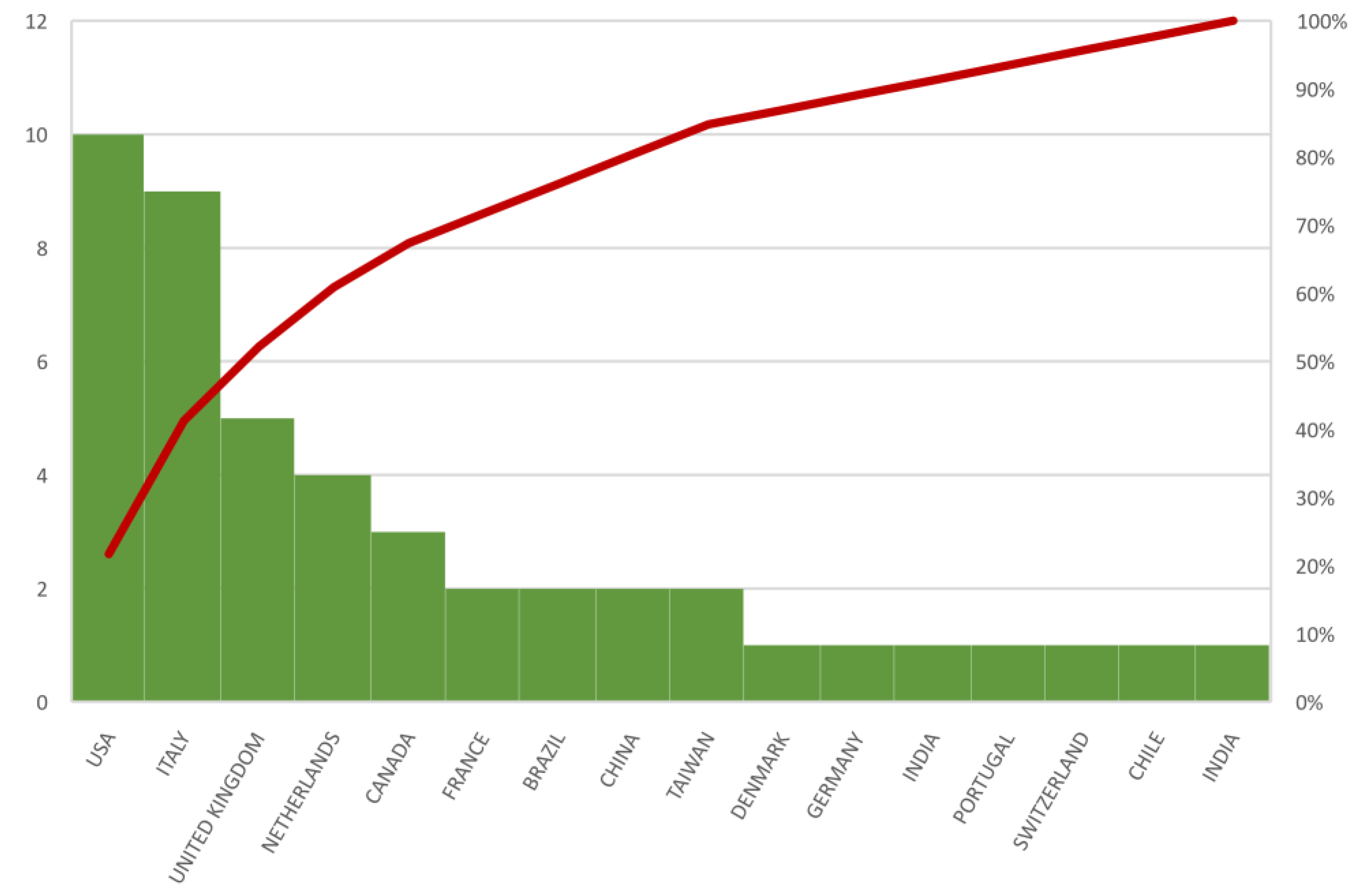

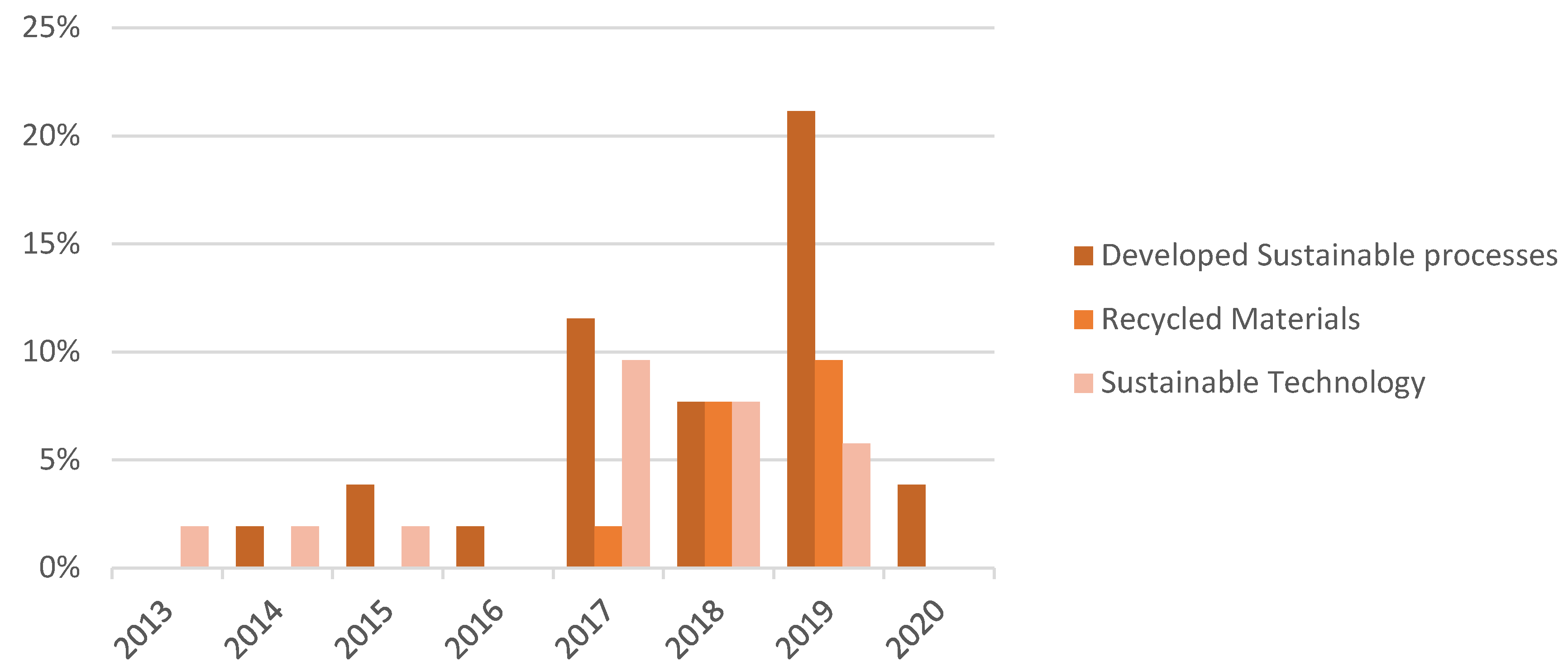
| Journals | BI | Sustainability |
|---|---|---|
| Additive Manufacturing | 5 | 2 |
| International Journal of Advanced Manufacturing Technology | 3 | 2 |
| International Journal of Production Economics | 2 | 1 |
| Journal of Manufacturing Systems | 2 | 2 |
| Journal of Manufacturing Technology Management | 1 | 1 |
| Technological Forecasting and Social Change | 1 | 1 |
| Journal Name | Topic | Number of Articles Published | |||||||||||||
|---|---|---|---|---|---|---|---|---|---|---|---|---|---|---|---|
| 2006 | 2007 | 2008 | 2010 | 2012 | 2013 | 2014 | 2015 | 2016 | 2017 | 2018 | 2019 | 2020 | Total | ||
| International Journal of Advanced Manufacturing Technology | Business Innovation | 1 | 1 | 1 | 2 | 5 | |||||||||
| International Journal of Production Economics | 1 | 1 | 1 | 3 | |||||||||||
| Rapid Prototyping Journal | 1 | 1 | 1 | 3 | |||||||||||
| Journal of Manufacturing Technology Management | 1 | 1 | 2 | ||||||||||||
| Journal of Thermal Spray Technology | 1 | 1 | 2 | ||||||||||||
| Proceedings of the Institution of Mechanical Engineers Part B-Journal of Engineering Manufacture | 1 | 1 | 2 | ||||||||||||
| Technological Forecasting and Social Change | 2 | 2 | |||||||||||||
| Additive Manufacturing | 1 | 1 | |||||||||||||
| British Food Journal | 1 | 1 | |||||||||||||
| Computers in Industry | 1 | 1 | |||||||||||||
| Entrepreneurship Research Journal | 1 | 1 | |||||||||||||
| Journal of Manufacturing Systems | 1 | 1 | |||||||||||||
| Journal of Mechanical Science and Technology | 1 | 1 | |||||||||||||
| Journal of Operations Management | 1 | 1 | |||||||||||||
| TOTAL: | 1 | 1 | 1 | 2 | 1 | 1 | 1 | 1 | 3 | 3 | 2 | 9 | 26 | ||
| Journal of Cleaner Production | Sustainability | 1 | 1 | 3 | 3 | 2 | 10 | ||||||||
| Journal of Industrial Ecology | 3 | 1 | 4 | ||||||||||||
| Materials | 1 | 2 | 3 | ||||||||||||
| Materials Today Communications | 3 | 3 | |||||||||||||
| California Management Review | 2 | 2 | |||||||||||||
| International Journal of Advanced Manufacturing Technology | 1 | 1 | 2 | ||||||||||||
| International Journal of Production Economics | 2 | 2 | |||||||||||||
| Journal of Manufacturing Technology Management | 1 | 1 | 2 | ||||||||||||
| Polymer Testing | 1 | 1 | 2 | ||||||||||||
| ACS Omega | 1 | 1 | |||||||||||||
| Additive Manufacturing | 1 | 1 | |||||||||||||
| Angewandte Chemie - International Edition | 1 | 1 | |||||||||||||
| Applied Sciences (Switzerland) | 1 | 1 | |||||||||||||
| CIRP Annals | 1 | 1 | |||||||||||||
| CIRP Journal of Manufacturing Science and Technology | 1 | 1 | |||||||||||||
| Clean Technologies and Environmental Policy | 1 | 1 | |||||||||||||
| Composites Part A: Applied Science and Manufacturing | 1 | 1 | |||||||||||||
| Energy for Sustainable Development | 1 | 1 | |||||||||||||
| Energy Policy | 1 | 1 | |||||||||||||
| International Journal of Intelligent Systems | 1 | 1 | |||||||||||||
| Journal of Manufacturing Systems | 1 | 1 | |||||||||||||
| Journal of Medical Systems | 1 | 1 | |||||||||||||
| Journal of Thermoplastic Composite Materials | 1 | 1 | |||||||||||||
| Mechatronics | 1 | 1 | |||||||||||||
| Polymers | 1 | 1 | |||||||||||||
| Powder Technology | 1 | 1 | |||||||||||||
| Processes | 1 | 1 | |||||||||||||
| Resources, Conservation and Recycling | 1 | 1 | |||||||||||||
| Sustainability | 1 | 1 | |||||||||||||
| Technological Forecasting and Social Change | 1 | 1 | |||||||||||||
| Virtual and Physical Prototyping | 1 | 1 | |||||||||||||
| TOTAL: | 1 | 2 | 3 | 1 | 12 | 12 | 19 | 2 | 52 | ||||||
| No. | Article | Total Citations (tc) | Tc/Year |
|---|---|---|---|
| 1 | [65] | 277 | 30.78 |
| 2 | [66] | 137 | 9.13 |
| 3 | [38] | 110 | 10.00 |
| 4 | [3] | 103 | 20.60 |
| 5 | [67] | 71 | 8.88 |
| 6 | [68] | 63 | 4.50 |
| 7 | [69] | 57 | 4.38 |
| 8 | [70] | 48 | 9.60 |
| 9 | [71] | 33 | 3.00 |
| 10 | [28] | 25 | 5.00 |
| No. | Article | Total Citations | Tc/Year |
|---|---|---|---|
| 1 | [72] | 246 | 35.143 |
| 2 | [63] | 185 | 23.125 |
| 3 | [9] | 132 | 22 |
| 4 | [73] | 82 | 20.5 |
| 5 | [74] | 52 | 13 |
| 6 | [75] | 49 | 9.8 |
| 7 | [76] | 39 | 9.75 |
| 8 | [77] | 29 | 7.25 |
| 9 | [78] | 28 | 9.333 |
| 10 | [32] | 28 | 9.333 |
| Author(s) | Year | Contribution/Assumption | AM Process | Reference |
|---|---|---|---|---|
| Neil Hopkinson and Phill Dickens [40] | 2003 | Cost comparison of injection molding with layer manufacturing process. Cost included: machine, labor, and material. | SLA FDM SLS | [38] [67] [80] [81] [82] |
| Massimiliano Ruffo et al. [66] | 2006 | Cost based on lifecycle costing, cost objective, and full costing. Assuming 100 h machine working time per week over 50 weeks/year. | SLS | [79] [66] [68] [82] |
| Ian Campbell [83] | 2008 | 2D schema time estimator to make a quotation before the STL file. The construction time of a single piece. | SLA | |
| Eleonora Atzeni et al. [38] | 2010 | AM cost characterization based on injection molding cost elements. The same piece could be fabricated by injection molding and AM. | SLS | [5] [67] [38] [82] |
| Lukas Rickenbacher et al. [67] | 2013 | Each part cost model estimator for a mixed build including pre- and post- processing. Same variables as in the 1998 Paul Alexander cost model. | SLM | [81] [82] |
| Martin Baumers et al. [80] | 2016 | Cost structure measurement model adapted from Ruffo and Hague, (2007). Raw material cost and energy consumption are considered as direct cost for the evaluation of both AM technologies. | EBM Direct Metal Laser Sintering (DMLS) | [82] |
| Marcello Fera et al. [81] | 2017 | Cost evaluation of relevant AM technologies when integrated with a general production process. Five generic process steps were assumed: preparation, build job, setup, building, and removal. | SLA SLS EBM | [82] |
| Yiran Yang and Lin Li [82] | 2018 | Cost model to evaluate the cost performance of simultaneous production with non-mixed and mixed geometries. Nonuniform energy cost per part for various geometries and some constants in formulation for an optimization problem. | Mask image projection SLA |
| Author (s) | Recycling Material | Demostrated for | Application |
|---|---|---|---|
| Fedor Kucherov et al. [76] | Biomass-derived red polyethylene-2,5-furandicarboxylate (PEF) | Fused deposition modeling | Better properties rather than the available materials for FDM. High thermal stability and low temperature, which are necessary for extrusion. |
| Aubrey Woern et al. [91] | Virgin polylactic acid (PLA), acrylonitrile butadiene styrene (ABS), polyethylene terephthalate (PET) and polypropylene (PP) | Fused particle fabrication | To prove the usability of a wide range of recycled polymer materials with minimal post processing. |
| Gigabot X1 | |||
| Joanna Paciorek-Sadowska et al. [92] | Eco-polyol based on polylactide (PLA) | Recycling of AM technology waste | Fast, cheap, and ecological management of polylactide waste with possible reuse. |
| Matthew Reich et al. [93] | Recycled polycarbonate | Stiffness and mechanical properties | Extrusion material for FDM |
| Author (s) | Year | Type of Process | Demonstrated for | Application |
|---|---|---|---|---|
| Jian Qin et al. [19] | 2020 | Energy consumption predictor | SLS | Deep learning-driven particle swarm optimization to optimize energy utility. |
| Jinghua Xu et al. [97] | 2020 | Energy efficiency optimization | FDM | 3DP energy optimization based on adaptative multi-layer customization considering material and greenhouse gas emissions |
| Paolo Priarone et al. [99] | 2019 | Framework for cases in which AM can substitute machining processes | Wire arc additive manufacturing | Framework that considers cost, manufacturing times, energy demand, and carbon footprint and in which machining can be replaced with AM process. |
| Abdollah Saboori et al. [101] | 2019 | Repair and restoration of metal parts | Direct energy deposition | Aerospace and automotive |
| Chris Turner et al. [20] | 2019 | Supply chain | Can be applied with any AM technology | Redistributed manufacturing closing the loop between customer and factories. |
| Sheng Yang et al. [102] | 2018 | Assembly design and part consolidation | SLM | LCA proposed to analyze of the environmental performance of assembly operations plus part consolidation via AM |
| Tobias Kamps et al. [95] | 2018 | Gear manufacturing | LBM | Life-cycle assessment of AM implementation for gear manufacturing enterprises, considering cost and energy efficiency. |
| Justin Bours et al. [98] | 2017 | Raw material evaluation | FDM PBF | Life-cycle assessment considering hazardous implication in material selection and environmental impact. |
| Yiran Yang et al. [82] | 2018 | Energy consumption predictor | SLA | Mathematical model for energy consumption in SLA AM technology considering various parameters and their potential interaction. |
| Anoop Verma and Rahul Rai [103] | 2017 | Energy consumption and material wastage | SLS | For sustainability analysis and optimization of parameters. |
| Paolo Priarone et al. [77] | 2017 | Energy consumption and CO2 emissions | SLM EBM | Combination of machining and AM process reduce energy demand and CO2 emissions. |
| Yunlong Tang et al. [75] | 2016 | Design, energy, and material consumption | Binder jetting | Environmental impact comparison between machining and AM technology |
| Osiris Canciglieri et al. [104] | 2015 | Prioritization for sustainable AM prototyping technologies. | SLS FDM | Proposed matrix to consider environmental and sustainable features in the design decision-making. |
© 2020 by the authors. Licensee MDPI, Basel, Switzerland. This article is an open access article distributed under the terms and conditions of the Creative Commons Attribution (CC BY) license (http://creativecommons.org/licenses/by/4.0/).
Share and Cite
Hernandez Korner, M.E.; Lambán, M.P.; Albajez, J.A.; Santolaria, J.; Ng Corrales, L.d.C.; Royo, J. Systematic Literature Review: Integration of Additive Manufacturing and Industry 4.0. Metals 2020, 10, 1061. https://doi.org/10.3390/met10081061
Hernandez Korner ME, Lambán MP, Albajez JA, Santolaria J, Ng Corrales LdC, Royo J. Systematic Literature Review: Integration of Additive Manufacturing and Industry 4.0. Metals. 2020; 10(8):1061. https://doi.org/10.3390/met10081061
Chicago/Turabian StyleHernandez Korner, Mario Enrique, María Pilar Lambán, José Antonio Albajez, Jorge Santolaria, Lisbeth del Carmen Ng Corrales, and Jesús Royo. 2020. "Systematic Literature Review: Integration of Additive Manufacturing and Industry 4.0" Metals 10, no. 8: 1061. https://doi.org/10.3390/met10081061
APA StyleHernandez Korner, M. E., Lambán, M. P., Albajez, J. A., Santolaria, J., Ng Corrales, L. d. C., & Royo, J. (2020). Systematic Literature Review: Integration of Additive Manufacturing and Industry 4.0. Metals, 10(8), 1061. https://doi.org/10.3390/met10081061







